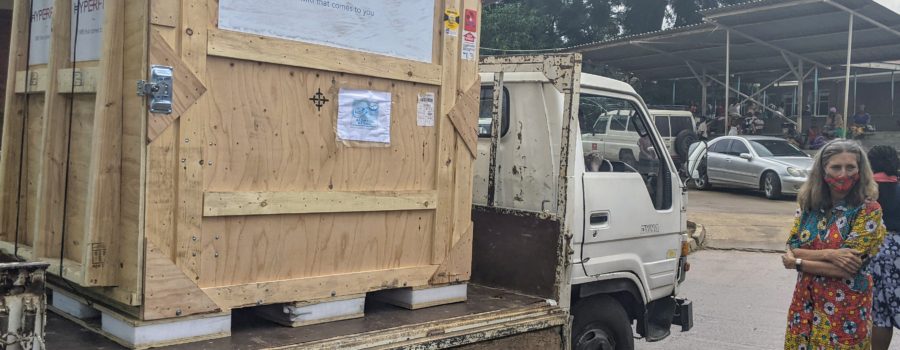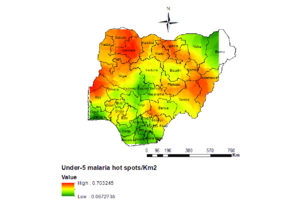When I am in Malawi, I simultaneously work on several research projects. These days my focus is on a Phase 3 clinical trial, “Treating Brain Swelling in Pediatric Cerebral Malaria.”
The “Treating Brain Swelling” clinical trial (“TBS” for even shorter) uses brain MRI to assess children prior to randomly assigning them to one of two new treatments. Only children who have cerebral malaria and a swollen brain are eligible. That sounds relatively simple until it is not. The trial was going well until December 2019 when Dr. Terrie Taylor, the study’s Principal Investigator, discovered that the MRI machine we used to scan patients in Blantyre was no longer functioning. We needed to start enrolling children in the clinical trial in January 2020, only a month later.
When an MRI breaks in a place like Malawi, getting it fixed is challenging and expensive. A General Electric technician flew in from Johannesburg to assess the problem. He said we needed a new gradient amplifier. Since the MRI scanner was old and no longer made, Dr. Taylor had to figure out where to find a refurbished gradient amplifier. eBay! The used part was shipped from New Jersey. A few weeks later, when the GE technician returned for installation, it sizzled and smoked. Not good.
It was March 2020 and everyone knows what happened then. In response to the global pandemic, Malawi closed itself off from the world. No flights. No way in or out. It was impossible to get another technician into Blantyre for a second opinion. The smoking, sizzling gradient amplifier cost tens of thousands of dollars. As anyone who owns a mobile phone knows, high technology has a finite lifespan. Putting more money and valuable time into trying to repair the General Electric machine was no longer reasonable.
We needed another plan. We wanted to do this important work and were stymied. If we did not start enrolling children, there was a concern that our future funding would be withdrawn, and we would never answer our research question: did either of these new treatments decrease death rates in children with cerebral malaria who had brain swelling?
Unfortunately, the 2020 malaria season in Malawi came and went. No children were enrolled in the clinical trial. The NIH temporarily forgave us, but we were all disappointed. The big General Electric MRI was still broken and there was no clear path to repair it. By mid-2020, Dr. Taylor identified another possibility, Hyperfine. Hyperfine Research was founded by Jonathan Rothberg, a very smart scientist whose entrepreneurial interests are wide-ranging. He founded a company that created (at the time) the smallest and fastest DNA sequencer in existence. In 2014, after likely doing very well financially, he founded a group of companies, one of which is Hyperfine. The company makes one product: a portable, (comparatively) inexpensive MRI scanner. Perfect! We had plenty of time before January 2021. We can get one of those shipped to Malawi in the autumn, learn how to use it, and restart enrolling children in the TBS clinical trial at the beginning of the 2021 malaria season.
The lightning and thunder were a celebration of our finally getting this machine to the Pediatric Research Ward.
Not so fast. Through the late summer and autumn of 2020, Dr. Taylor went through the many steps needed to acquire a Hyperfine scanner for our use. She got approvals from the NIH, then her University, then a lot of lawyers at both Hyperfine and her University. We projected the scanner would be in place in November 2020. Then December 2020. Still no scanner. Tick tock.
Finally, in early January 2021 the approvals were in place and the shipping company was ready. Hyperfine let us know that it would be preferable (required, honestly) to have someone come to their headquarters in Guilford, Connecticut, to learn how to remove the custom built packing material, drive the scanner out of its specially built shipping crate, and set it up. All the other TBS personnel were already in Malawi, preparing for the scanner’s imminent arrival. That meant I got to do this.
I went to Connecticut to learn the required steps. Brian Welch and Samantha By at Hyperfine were very patient as I drove the scanner forward, backwards, and performed a scan. It was a bit challenging but very doable.
Later that same week I flew to Malawi. I had to leave and get there quickly as our new scanner was on its way. It was to start at Kennedy airport and go onto Dubai and Addis Ababa before arriving in the Warm Heart of Africa. All good.
Until it was not. The shipping company was, in my opinion, incompetent. Preparing to load the scanner onto the plane at JFK, they realized it would not fit through the cargo door. This caused a reroute to Johannesburg; a plane was not leaving for another week. Two days before they were to load the scanner on the plane to South Africa, they realized there were lithium ion batteries aboard. Another re-schedule. Eventually, six weeks after I raced to Blantyre, the scanner reached Johannesburg. One can drive non-stop between the airport and Blantyre in 24 hours. The shipping company said it would be another two weeks. At this point, one must resign to one’s fate. Dozens of phone calls and terse emails from both Hyperfine and our group could do nothing in the face of this ineptitude.
I was scheduled to return to the USA on 12 March. Leaving Johannesburg in late February, the shippers estimated delivery on the 10th. Then the 11th. Eventually, the Fates were with us. Late in the morning of 11 March 2021, eighteen hours prior to my departure from Malawi, the Hyperfine scanner arrived at Queen Elizabeth Central Hospital. A forklift placed the shipping crate outside of the doors to the pediatrics ward. The sky darkened and the winds picked up. I hurried to perform the many steps necessary to get the scanner inside of the building before the rains began.
I did it. I drove the scanner inside moments before the heavens opened. The lightning and thunder were a celebration of our finally getting this machine to the Pediatric Research Ward. Viqas Chowdhury, the husband of one of my co-workers (and technology whiz) set up the Bluetooth and WiFi and configured the iPad controller. Four hours after its arrival, we scanned our first patient. Today, seven days later, the Treating Brain Swelling clinical trial is getting ready to randomize once again.
One of Hyperfine company missions is, by lowering costs, to bring technology to places where it would otherwise not usually be available. This was the first time the company had placed a scanner outside of the USA. We all learned a lot from this experience. The five P’s of Life come to mind: Patience, Persistence, Perseverance, Passion, and Purpose.






